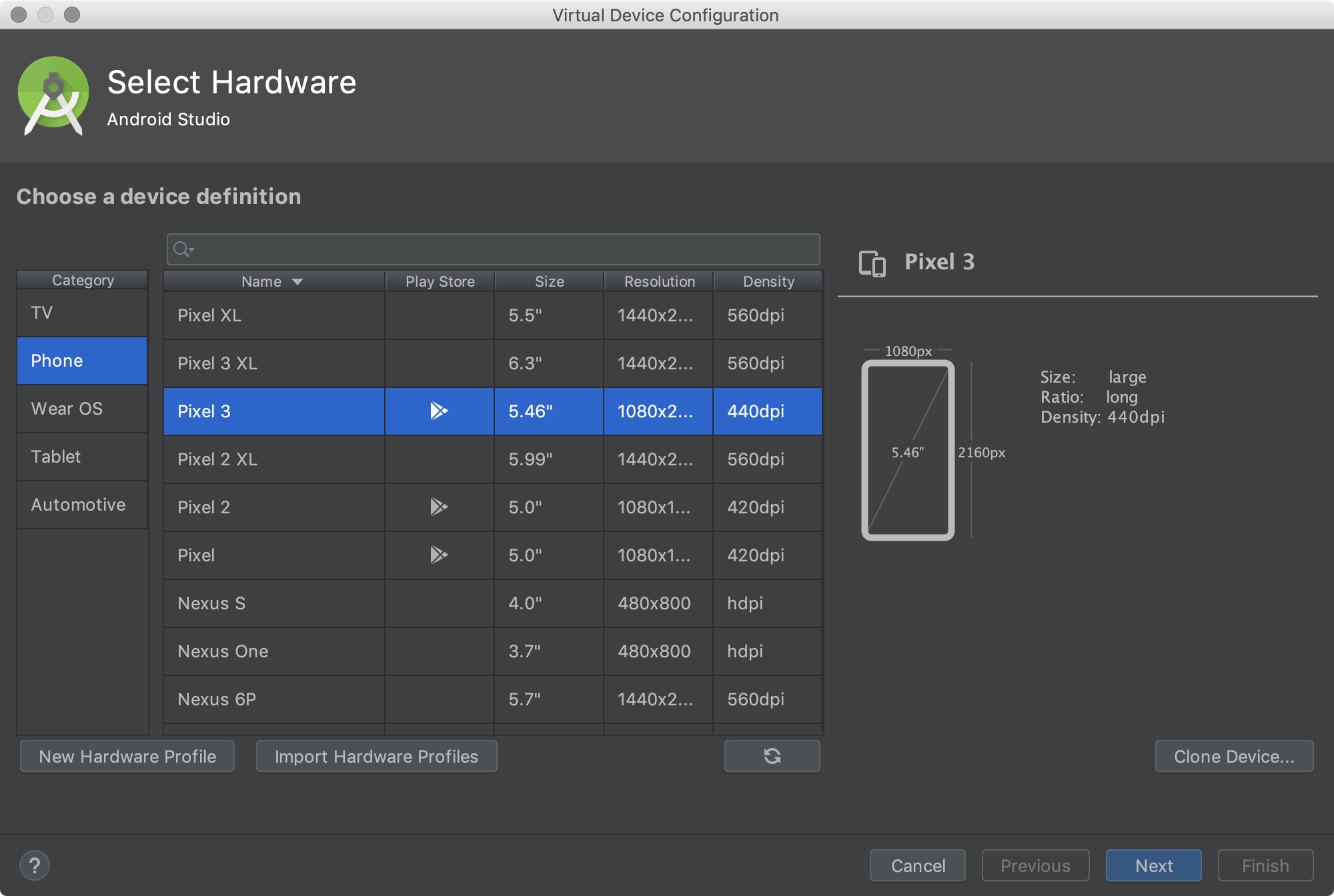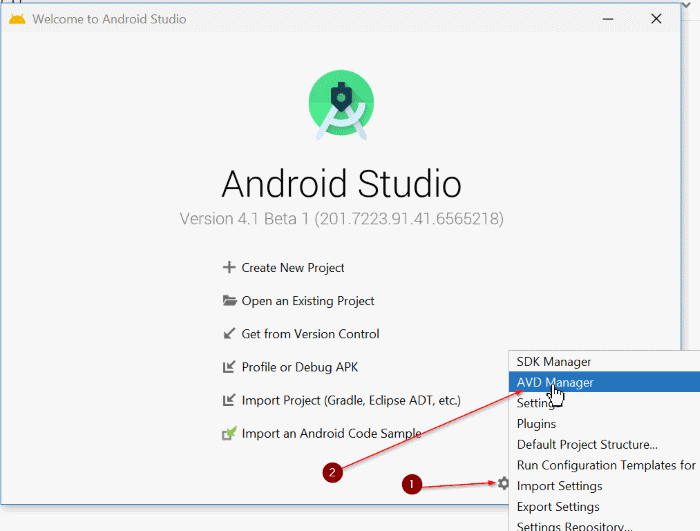The AVD Manager is an easy to use user interface to manage your AVD (Android Virtual Device) configurations. An AVD is a device configuration for the Android emulator that allows you to model different configurations of Android-powered devices. When you start the AVD Manager in Eclipse or navigate to your SDK's tools/ directory and execute android avd. You will see the AVD Manager as shown in figure 1.
- Android Avd Manager Mac
- Download Android Virtual Device Manager
- Avd Manager Mac Torrent
- Android Virtual Devices Download
- Verify the AVD configuration is correct, and select Finish. For details on the above steps, see Managing AVDs. In Android Virtual Device Manager, click Run in the toolbar. The emulator starts up and displays the default canvas for your selected OS version and device. Agree to Android Licenses.
- Android Emulator Android SDK Path Android Studio Android Studio beginners Android Studio Tutorial AVD AVD Manager AVD Properties Commandline Install.
- To open the AVD Manager, do one of the following: Select Tools AVD Manager. Click AVD Manager in the toolbar.
Mac-os-x avd-manager. Improve this question. Follow edited Nov 28 '19 at 10:07. Asked Nov 22 '19 at 10:14. Mars Robertson Mars Robertson. Genymotion is a fast and wonderful third party emulator that can be used to create a virtual environment for Android. It is the fastest Android emulator on the earth. It can be used to develop, test and run Android apps on Mac PC. It is available for Windows, Mac, and Linux machine.
Figure 1. Screenshot of the AVD Manager. Photo booth.
From the main screen, you can create, delete, repair and start AVDs as well as see the details of each AVD.
Creating an AVD
You can create as many AVDs as you would like to test on. It is recommended that you test your applications on all API levels higher than the target API level for your application.
To create an AVD:
- Start the AVD Manager:
- In Eclipse: select Window > AVD Manager, or click the AVD Manager icon in the Eclipse toolbar.
- In other IDEs: Navigate to your SDK's
tools/directory and execute theandroidtool with no arguments.
In the Virtual Devices panel, you'll see a list of existing AVDs. Click New to create a new AVD. The Create New AVD dialog appears.
Figure 2. Screenshot of the Create AVD window
- Fill in the details for the AVD.
Give it a name, a platform target, an SD card size, and a skin (HVGA is default). You can also add specific hardware features of the emulated device by clicking the New.. button and selecting the feature. For a list of hardware features, see Hardware options.
Note: Be sure to define a target for your AVD that satisfies your application's Build Target (the AVD platform target must have an API Level equal to or greater than the API Level that your application compiles against).
- Click Create AVD.
Your AVD is now ready and you can either close the AVD Manager, create more AVDs, or launch an emulator with the AVD by selecting a device and clicking Start.
Hardware options
If you are creating a new AVD, you can specify the following hardware options for the AVDto emulate:
| Characteristic | Description | Property |
|---|---|---|
| Device ram size | The amount of physical RAM on the device, in megabytes. Default value is '96'. | hw.ramSize |
| Touch-screen support | Whether there is a touch screen or not on the device. Default value is 'yes'. | hw.touchScreen |
| Trackball support | Whether there is a trackball on the device. Default value is 'yes'. | hw.trackBall |
| Keyboard support | Whether the device has a QWERTY keyboard. Default value is 'yes'. | hw.keyboard |
| DPad support | Whether the device has DPad keys. Default value is 'yes'. | hw.dPad |
| GSM modem support | Whether there is a GSM modem in the device. Default value is 'yes'. | hw.gsmModem |
| Camera support | Whether the device has a camera. Default value is 'no'. | hw.camera |
| Maximum horizontal camera pixels | Default value is '640'. | hw.camera.maxHorizontalPixels |
| Maximum vertical camera pixels | Default value is '480'. | hw.camera.maxVerticalPixels |
| GPS support | Whether there is a GPS in the device. Default value is 'yes'. | hw.gps |
| Battery support | Whether the device can run on a battery. Default value is 'yes'. | hw.battery |
| Accelerometer | Whether there is an accelerometer in the device. Default value is 'yes'. | hw.accelerometer |
| Audio recording support | Whether the device can record audio. Default value is 'yes'. | hw.audioInput |
| Audio playback support | Whether the device can play audio. Default value is 'yes'. | hw.audioOutput |
| SD Card support | Whether the device supports insertion/removal of virtual SD Cards. Default value is 'yes'. | hw.sdCard |
| Cache partition support | Whether we use a /cache partition on the device. Default value is 'yes'. | disk.cachePartition |
| Cache partition size | Default value is '66MB'. | disk.cachePartition.size |
| Abstracted LCD density | Sets the generalized density characteristic used by the AVD's screen. Default value is '160'. | hw.lcd.density |
I recently had trouble deleting old emulators from my AVD Manager.

The Android Virtual Device 'myEmulator' is currently running an emulator and cannot be deleted.
I did delete all the AVD processes that were running on my Mac OS X but still, the error persisted. (check if AVD is running through Activity Monitor on Mac or Task Manager on Windows)
To resolve this issue you need to locate the .android folder on your HDD. The location for
Android Avd Manager Mac
.android
folder is different depending on what Operating System you have.
macOS/Linux/UNIX
- Go to terminal.
- Goto root by typing : cd
- Goto Users/
- Now type : cd .android
- Now type : cd avd
You would see directories with emulator names. Delete all those emulator's (.ini and .avd) files from here that you do not want.

Alternate way: You need to unhide hidden folders on your Mac OS X to see .android folder. ( how to see hidden folders on macOS: link )
Goto Users Directory where Android Eclipse software has been installed. Now look for a hidden .android directory. Get into AVD dir and delete the file and folder that have your emulator name.
Go-to AVD Manager and refresh and you would see that the AVD is been deleted.
Windows XP, Vista, 7, 8
Download Android Virtual Device Manager
For Windows Operating system you will find .android folder under C:/Documents and Settings//.android
Animal jam hacking. This can be C:/Users/.android if you are running Windows 7 or Windows 8
Avd Manager Mac Torrent
Now look for AVD folder and delete all folders and files (.ini files) that has the name of the AVD you do not want

Hope it helps!
Android Virtual Devices Download
- Detect Data roaming in Android Application - Android
- How to add ruler in Sublime Text tab window - Sublime-Text
- Compare two text files in Notepad++ - NotepadPlusPlus
- Error: Can not find the tag library descriptor for - Java
- Display full website address in Safari macOS Browser - MacOS